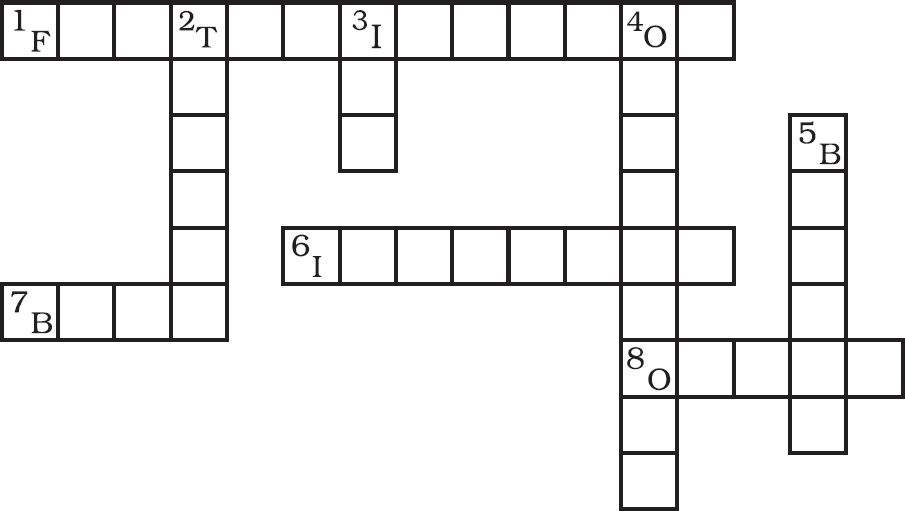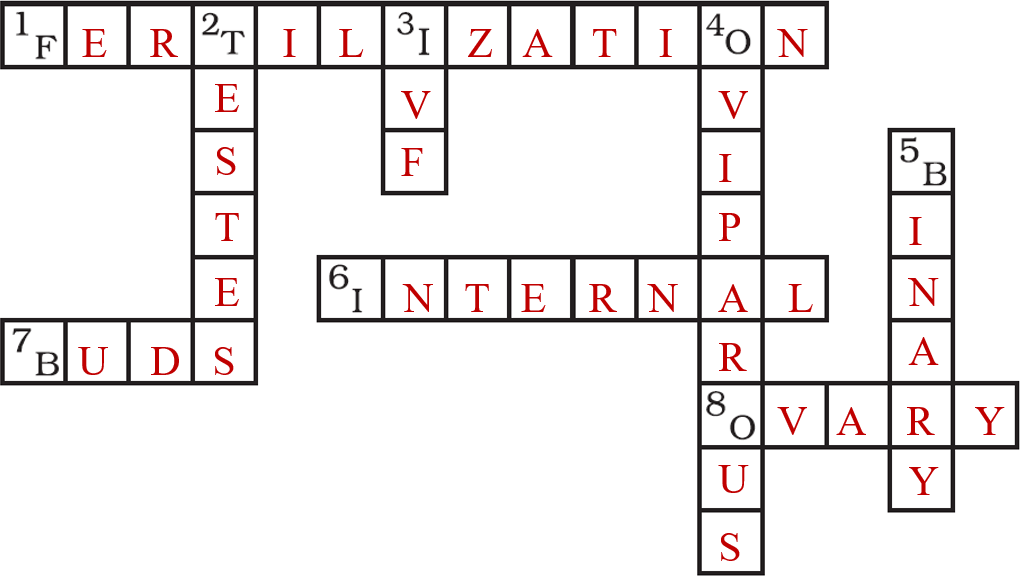Chapter 9 - Reproduction in Animals
Question 1: Define
a) Reproduction - Reproduction is a process by which living things give birth to a new generation of organisms of same kind.
b) Zygote - The fertilized egg is called zygote. During fertilization, the nuclei of the sperm and the egg fuse to form a single nucleus. This results in formation of zygote.
c) Oviparous - The animals which lay the eggs are called oviparous animals. Example: Birds, Frogs, Starfish etc.
d) Viviparous - The animal which give birth to young ones are called viviparous animals. Example: Dogs, Humans etc.
e) Gestation period - The development of the foetus from the time of fertilization in the womb of its mother is called gestation period.
f) Fertilization - The fusion of the genetic material contained in the gametes to form a zygote is called fertilization.
g) Metamorphosis - The transformation of the larva into adults through drastic changes is called metamorphosis.
h) Implantation - When the embryo gets embedded in the wall of the uterus it is called implantation.
Question 2: What are the two main modes of reproduction? Explain in brief.
Answer: There are two main modes of reproduction
• Sexual reproduction
The reproduction in organisms by the union of the male and female cells (gametes) is called sexual reproduction. When sperms come in contact with an egg, one of the sperms may fuse with the egg. Such fusion of the egg and the sperm is called fertilization. During fertilization, the nuclei of the sperm and the egg fuse to form a single nucleus. This results in the formation of fertilized egg or the zygote. The zygote divides repeatedly to give rise to a ball of cells. The cells hen being to form groups that develop into different tissues and organs of the body. This developing structure is termed as embryo. The embryo gets embedded in the wall of the uterus for further development. The embryo continues to develop in the uterus. It gradually develops body parts such as hands, legs, head etc. The stage of the embryo in which all the body parts can be identified is called a foetus. When the development of the foetus is complete, the mother gives birth to the baby.
• Asexual reproduction
The reproduction in which offspring are produced by a single parent, without the union of sex cells is called asexual reproduction.
→ Budding in Hydra
In each hydra, there may be one or more bulges. These bulges are the developing new individuals and they are called buds. In hydra too the new individuals develop as outgrowths from a single parent. This type of reproduction in which only a single parent is involved is called asexual reproduction. Since new individuals develop from the buds in hydra, this type of asexual reproduction is called budding.
→ Binary fission in Amoeba
Amoeba is a single-celled organism. It begins the process of reproduction by the division of its nucleus into two nuclei. This is followed by division of its body into two, each part receiving a nucleus. Finally, two amoebae are produced from one parent amoeba. This type of asexual reproduction in which an animal reproduces by dividing into two individuals is called binary fission.
Question 3: Explain the importance of reproduction in organisms.
Answer: Reproduction is important because without it, a species wouldn’t survive over time. Individuals must reproduce to ensure that they will continue on over generation of time.
Question 4: Describe the process of fertilization in human beings.
Answer: The first step in the process of reproduction is the fusion of a sperm and an ovum. When sperms come in contact with an egg, one of the sperms may fuse with the egg. Such fusion of the egg and the sperm is called fertilization. During fertilization, the nuclei of the sperm and the egg fuse to form a single nucleus. This results in the formation of a fertilized egg or zygote. The zygote divides repeatedly to give rise to a ball of cells. The cells then begin to form groups that develop into different tissues and organs of the body. This developing structure is termed an embryo. The embryo gets embedded in the wall of the uterus for further development. The embryo continues to develop in the uterus. It gradually develops body parts such as hands, legs, head, eyes, ears etc. The stage of the embryo in which all the body parts can be identified is called a foetus. When the development of the foetus is complete, the mother gives birth to the baby.
Question 5: Choose the most appropriate answer.
a) Internal fertilisation occurs
i) in female body.
ii) outside female body.
iii) in male body.
iv) outside male body.
Answer: i) in female body.
b) A tadpole develops into an adult frog by the process of
i) fertilisation
ii) metamorphosis
iii) embedding
iv) budding
Answer: ii) metamorphosis
c) The number of nuclei present in a zygote is
i) none
ii) one
iii) two
iv) four
Answer: ii) one
Question 6: Indicate whether the following statements are True (T) or False (F).
a) Oviparous animals give birth to young ones.
b) Each sperm is a single cell.
c) External fertilisation takes place in frog.
d) A new human individual develops from a cell called gamete.
e) Egg laid after fertilisation is made up of a single cell.
f) Amoeba reproduces by budding.
g) Fertilisation is necessary even in asexual reproduction.
h) Binary fission is a method of asexual reproduction.
i) A zygote is formed as a result of fertilisation.
j) An embryo is made up of a single cell.
Answer:
a) False
b) True
c) True
d) False
e) True
f) False
g) False
h) True
i) True
j) False
Question 7: Give two differences between a zygote and a foetus.
Answer:
• Zygote
→ It is the earliest stage of development.
→ It is formed by the fusion of the male and the female gametes.
→ It is a single cell.
→ The zygote divides repeatedly to form embryo.
• Foetus
→ It is last developmental stage of human.
→ The stage of the embryo that shows all the main recognizable body parts of a mature organism.
→ The foetus stage occurs after the embryo stage.
→ Foetus mainly undergoes internal development.
Question 8: Define asexual reproduction. Describe two methods of asexual reproduction in animals.
Answer: The reproduction in which off spring are produced by a single parent, without the union of the sex cell is called asexual reproduction.
• Budding in hydra
→ The first step is the formation of buds and it develops as a small outgrowth on the parent body.
→ As buds enlarge, it gets the characteristics of the parent organism.
→ Once it is completely developed, it gets detached from the parent body and develops into new organism.
→ Sometimes, the buds may not be detached from parent forming interconnected buds.
• Binary fission in amoeba
→ It is a type of asexual reproduction in which one cell divides into two halves.
→ It is a unicellular organism that has a cell membrane, cell wall and cytoplasm.
→ In this process, the nucleus of the amoeba first divides to form two daughter nuclei by process called karyokinesis.
Question 9: In which female reproduction organ does the embryo get embedded?
Answer: In the female reproductive organ, the embryo gets attached to the uterus. Once it gets attached, there occurs the formation of body parts like hand, legs etc. Then the embryo is called foetus.
Question 10: What is metamorphosis? Give examples.
Answer: The transformation of the larva into adults through drastic change is called metamorphosis. It is a biological process. Example, frogs and insects.
Question 11: Differentiate between internal fertilization and external fertilization.
Answer:
• Internal fertilization - It is a fertilization which takes place inside the body of the female. Example: cows, humans, dogs etc.
• External fertilization - It is a fertilization which takes place outside the body. Example: fish, frog etc.
Question 12: Complete the crossword puzzle using the hints given below.
Across
1. The process of the fusion of the gametes.
6. The type of fertilisation in hen.
7. The term used for bulges observed on the sides of the body of hydra.
8. Eggs are produced here.
Down
2. Sperms are produced in these male reproductive organs.
3. Another term for in vitro fertilisation.
4. These animals lay eggs.
5. A type of fission in amoeba.

Answer:

No comments:
Post a Comment